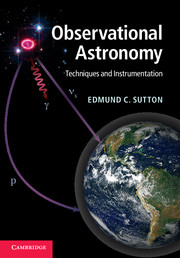Book contents
- Frontmatter
- Contents
- List of illustrations
- List of tables
- Preface
- Acknowledgements
- 1 Astrophysical information
- 2 Photometry
- 3 Positional astronomy
- 4 Fourier transforms
- 5 Detection systems
- 6 Orthodox statistics
- 7 Stochastic processes and noise
- 8 Optics
- 9 Interference
- 10 Spectroscopy
- 11 Ultraviolet, x-ray, and gamma ray astronomy
- 12 Radio receivers, spectrometers, and interferometers
- 13 Modern statistical methods
- 14 Neutrino detectors
- 15 Cosmic ray detectors
- 16 Gravitational waves
- 17 Polarimetry
- Appendix A Physical constants and units
- Appendix B Acronyms
- Appendix C Additional reading
- References
- Index
- Plates
12 - Radio receivers, spectrometers, and interferometers
Published online by Cambridge University Press: 05 June 2012
- Frontmatter
- Contents
- List of illustrations
- List of tables
- Preface
- Acknowledgements
- 1 Astrophysical information
- 2 Photometry
- 3 Positional astronomy
- 4 Fourier transforms
- 5 Detection systems
- 6 Orthodox statistics
- 7 Stochastic processes and noise
- 8 Optics
- 9 Interference
- 10 Spectroscopy
- 11 Ultraviolet, x-ray, and gamma ray astronomy
- 12 Radio receivers, spectrometers, and interferometers
- 13 Modern statistical methods
- 14 Neutrino detectors
- 15 Cosmic ray detectors
- 16 Gravitational waves
- 17 Polarimetry
- Appendix A Physical constants and units
- Appendix B Acronyms
- Appendix C Additional reading
- References
- Index
- Plates
Summary
Astrophysical radio sources
Most astronomical radio sources are fundamentally different than the most common optical sources, stars. Some radio continuum sources exhibit thermal emission, in which flux increases with frequency (remember that Sν ∝ ν2 at low frequencies for a blackbody). This type of spectrum is characteristic of thermal bremsstrahlung, also known as free–free emission, from a hot electron plasma such as an H II region, as shown in Figure 12.1. At low frequencies such a source is optically thick and the spectrum rises as ν2. At high frequencies such a source becomes optically thin, and the spectrum is nearly flat. The cosmic microwave background (CMB) is another example of a thermal source. Other continuum sources are non-thermal, with flux increasing at longer wavelengths. A typical spectrum from synchrotron radiation varies as Sν ∝ ν-0.8. The spatial structure of the emitting region is often quite complex and of great importance astrophysically. Spectral line emission at radio wavelengths comes from the 21 cm hyperfine structure line of H I (a tracer of neutral hydrogen), from recombination lines primarily of H and He (useful as probes of ionization conditions), and from molecular rotational lines (probes of dense gas and star forming regions). Some radio sources show rapid temporal variations (pulsars).
Fundamentals of radio receivers
At radio frequencies (λ ≳ 300 μm; ν ≲ 1012 Hz) generally the wave picture of electromagnetic radiation is more appropriate than the photon picture.
- Type
- Chapter
- Information
- Observational AstronomyTechniques and Instrumentation, pp. 209 - 232Publisher: Cambridge University PressPrint publication year: 2011



